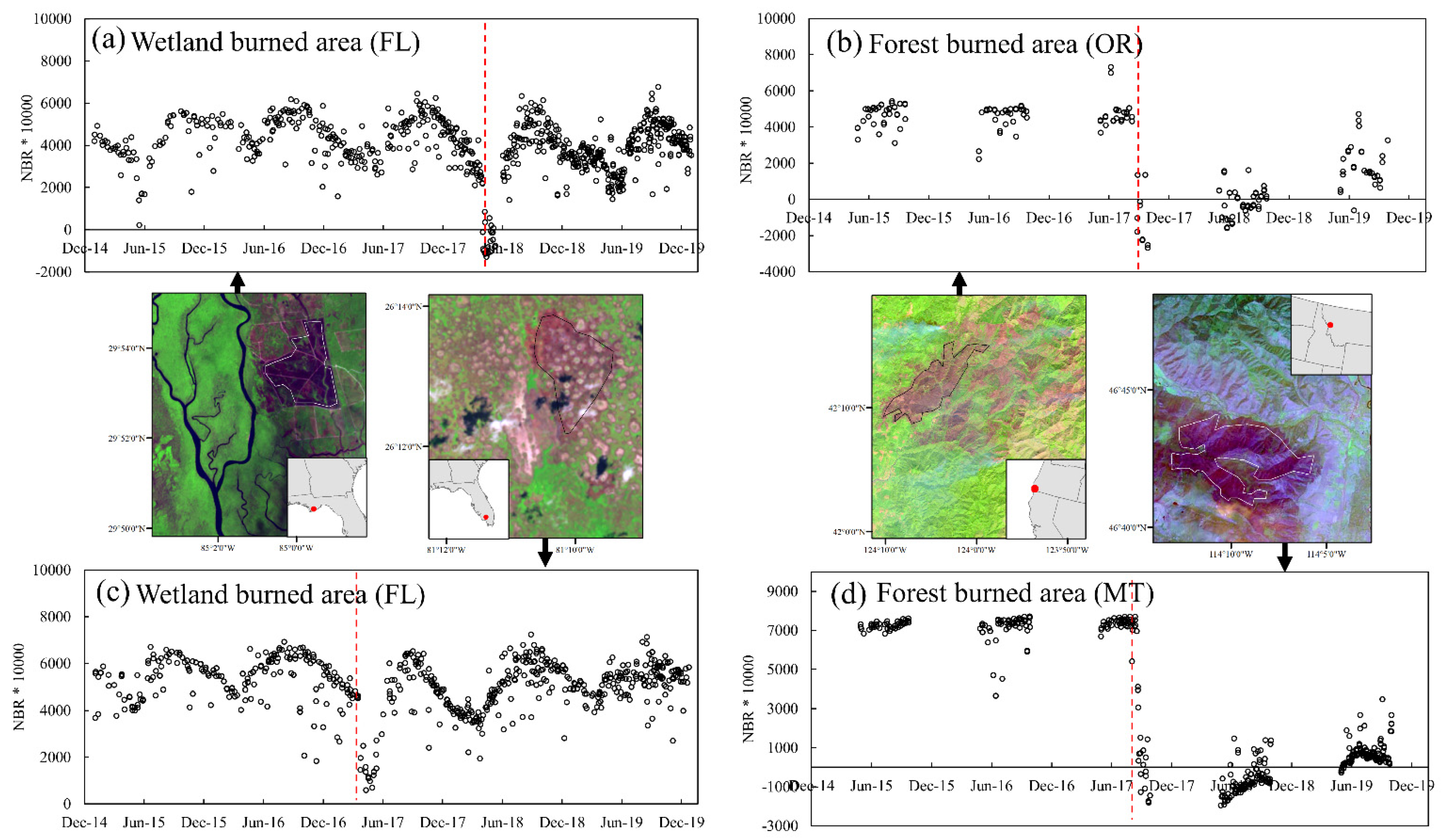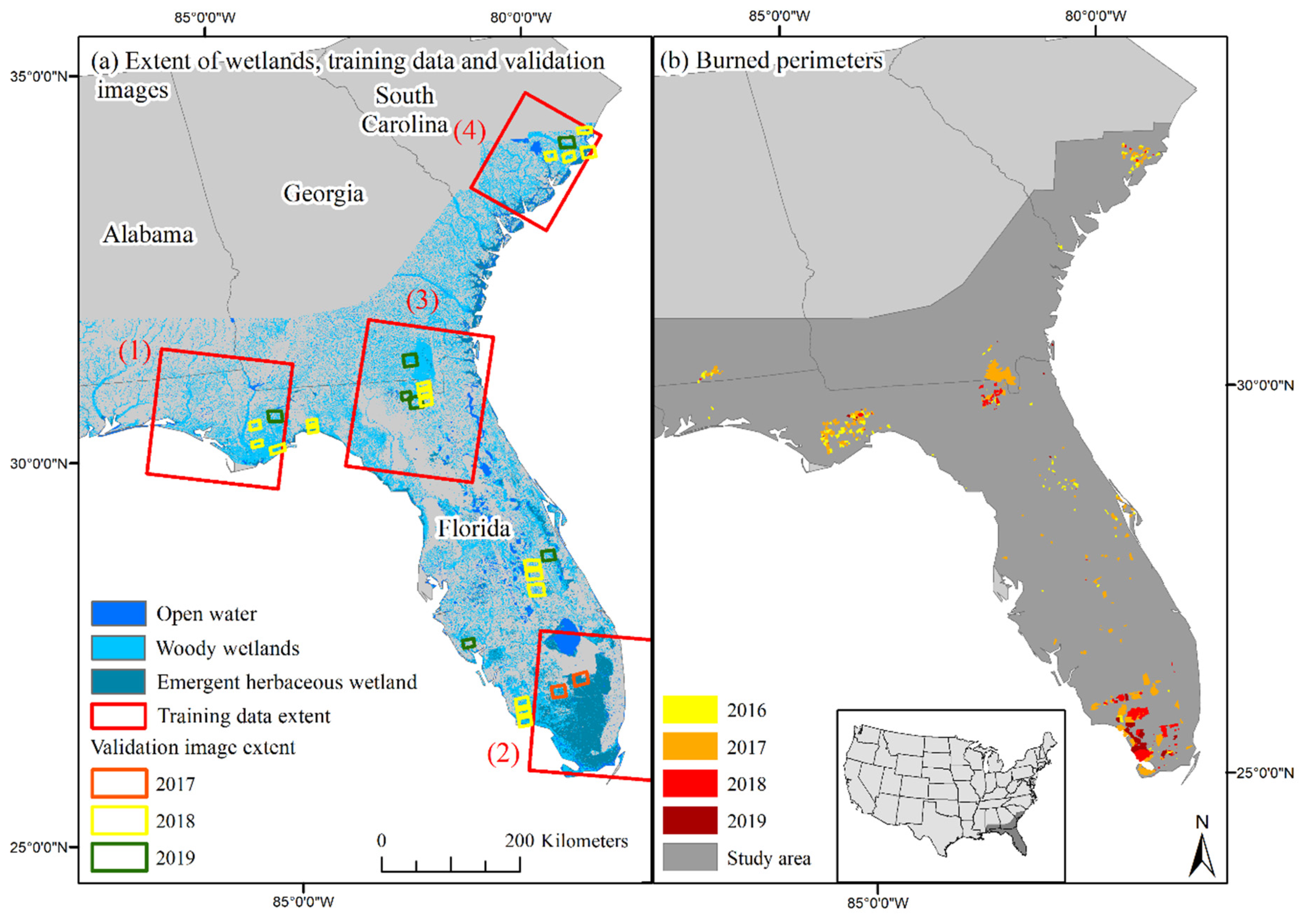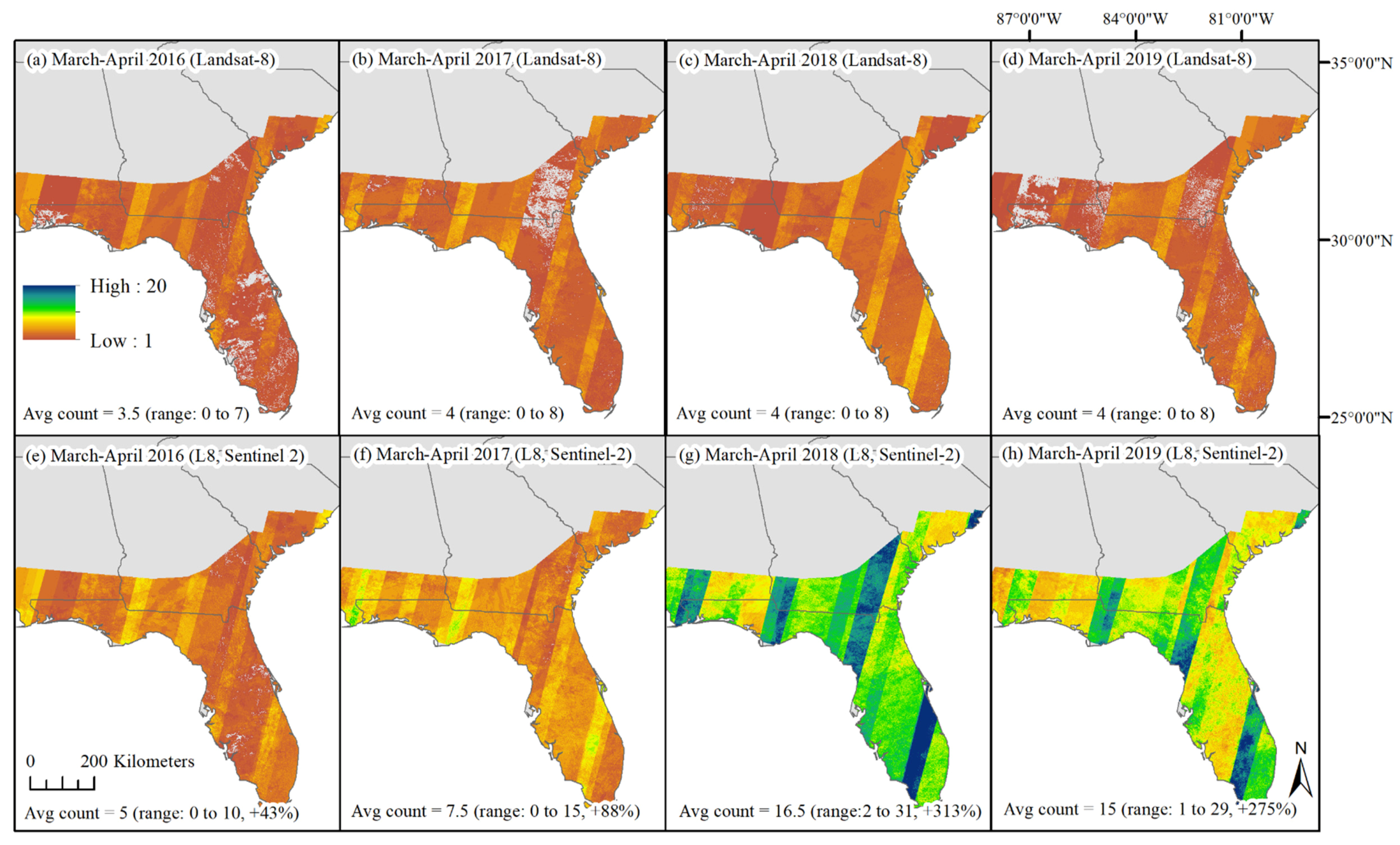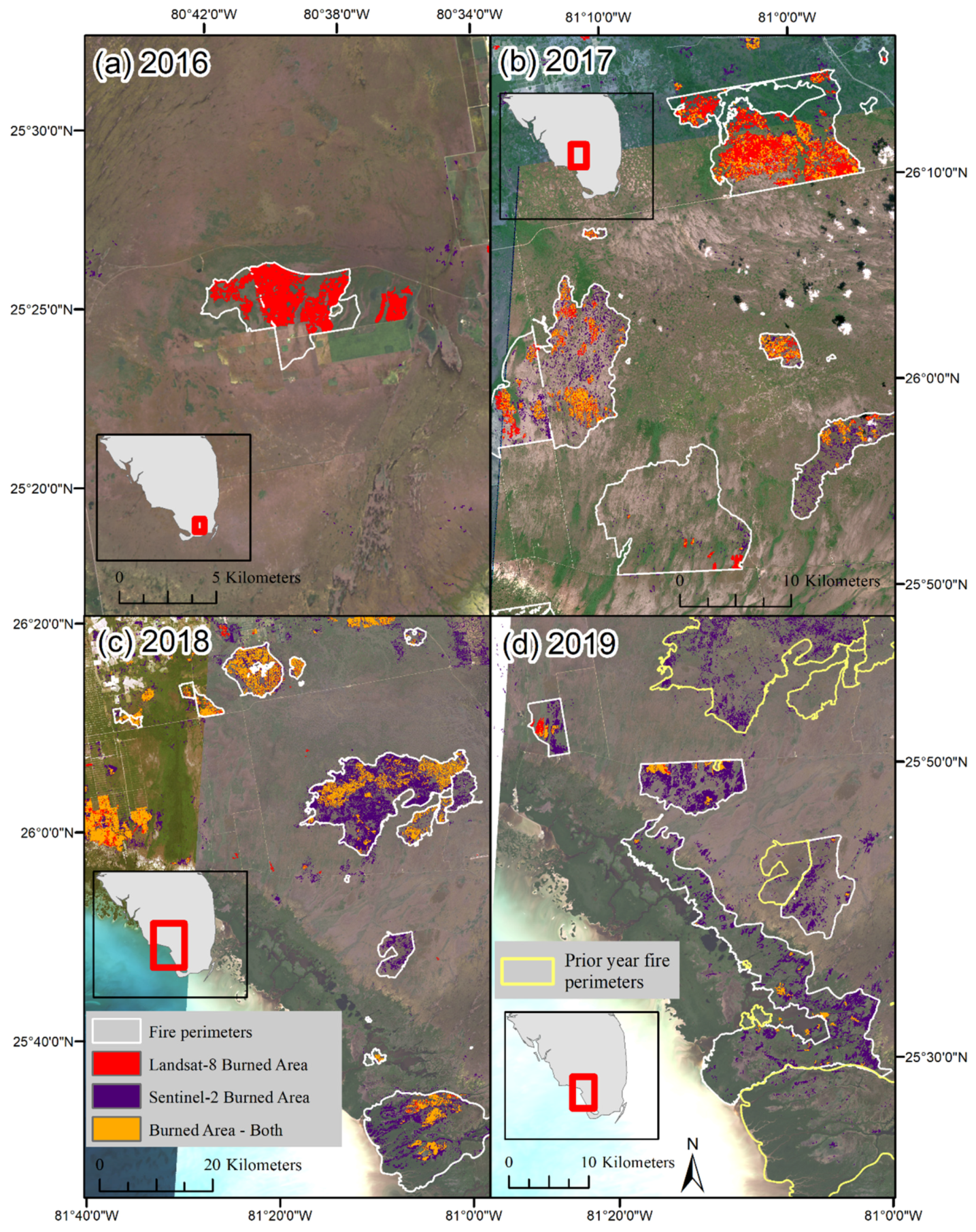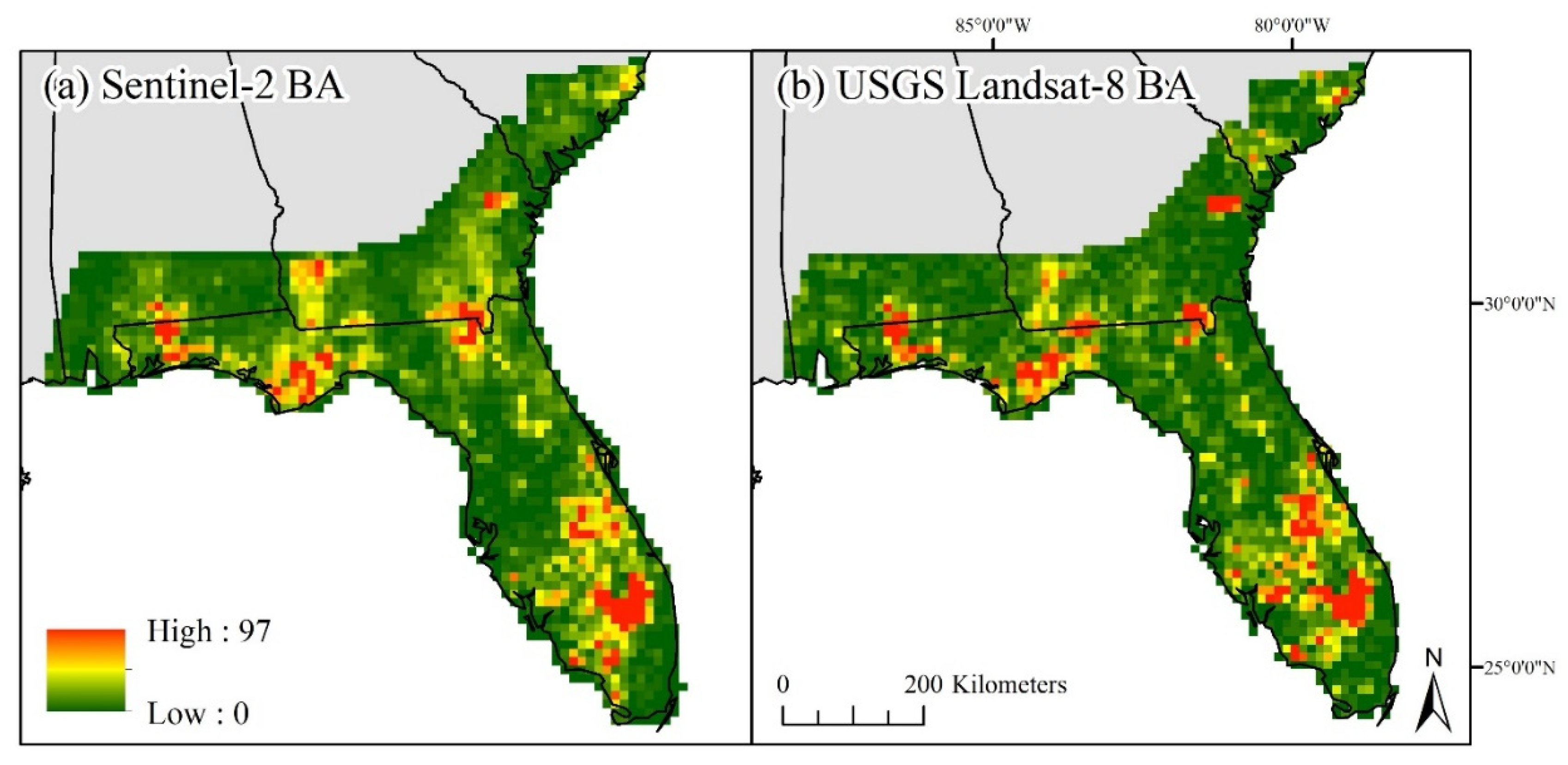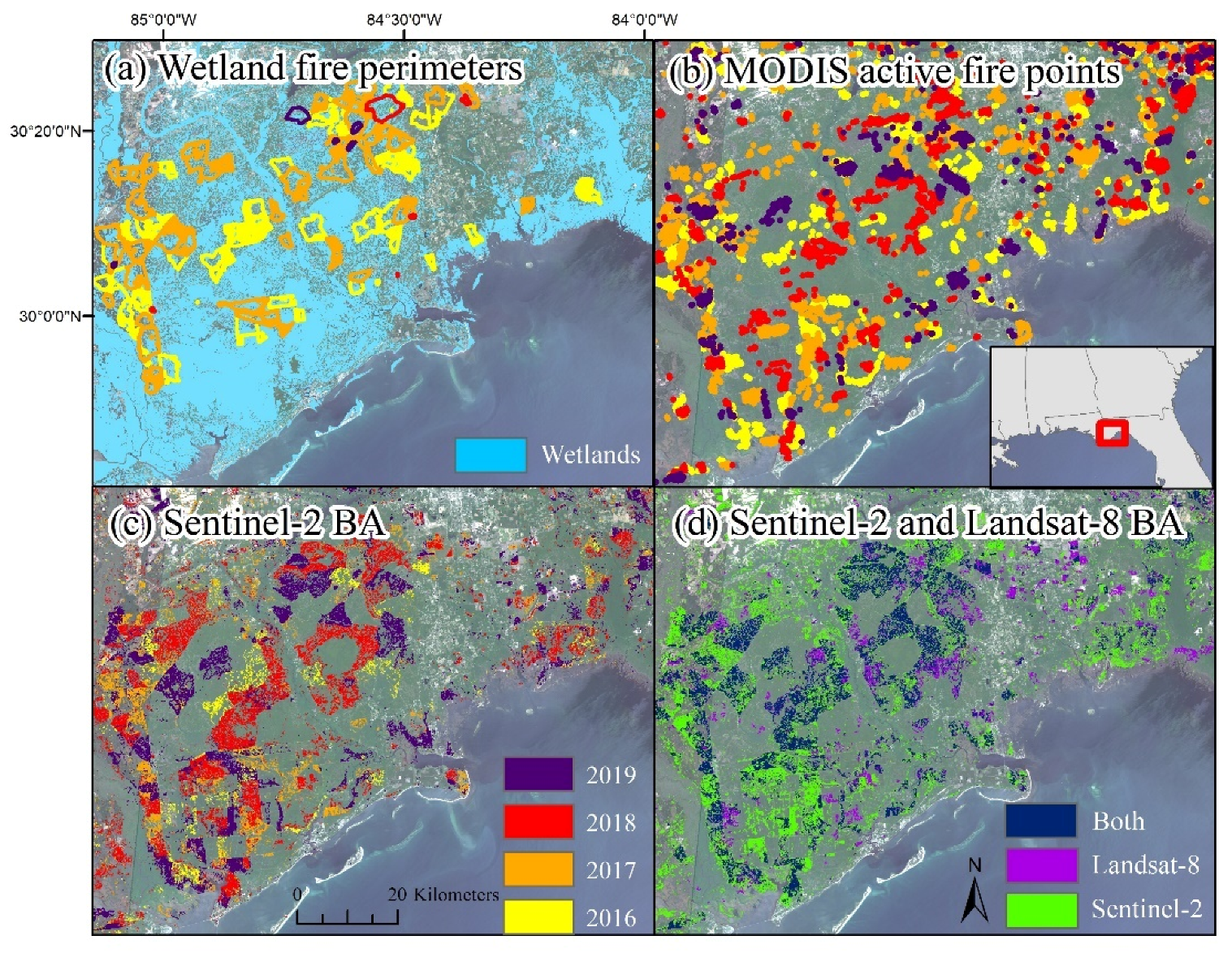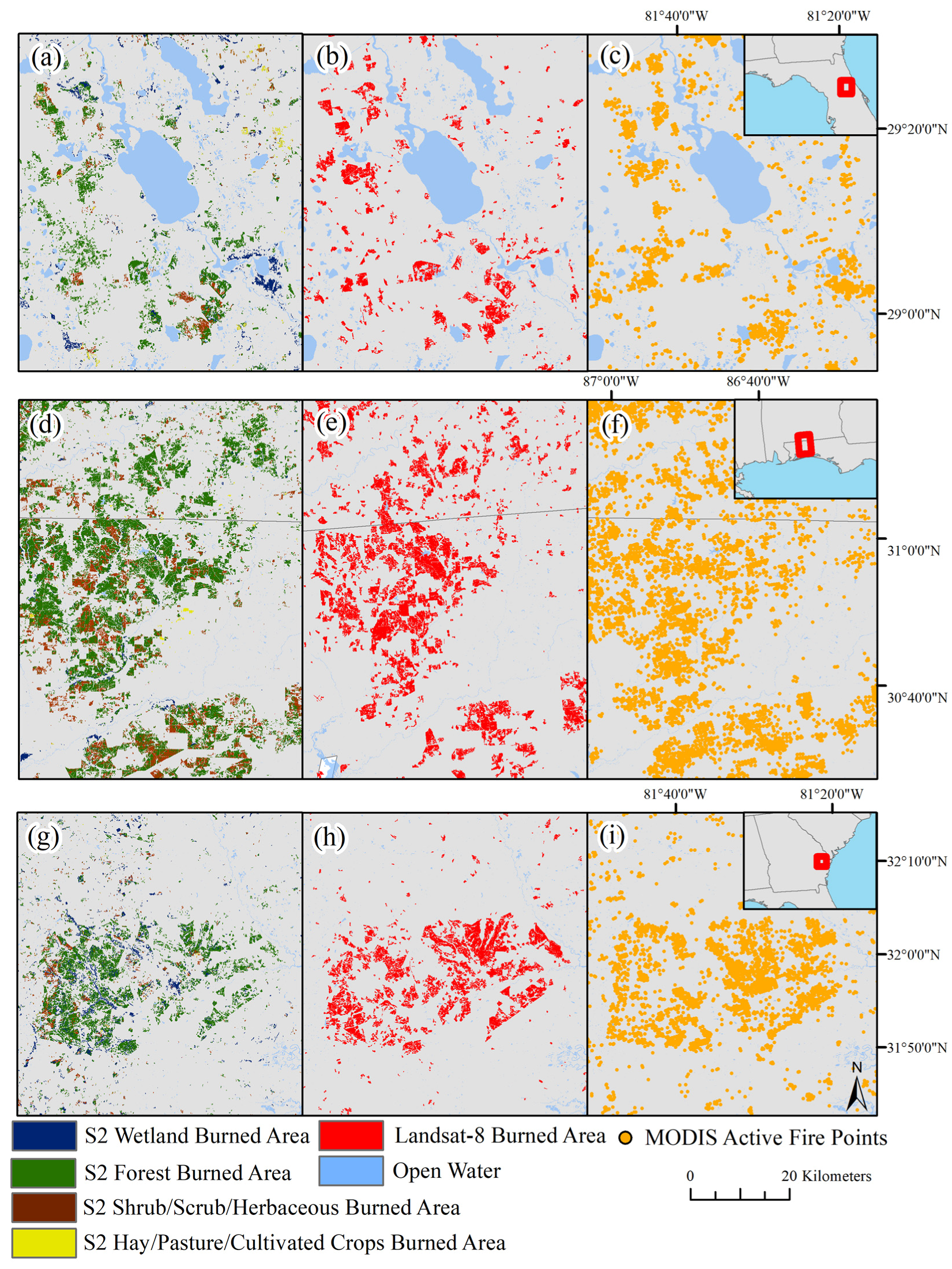1. Introduction
Wetland ecosystems, characterized by permanent or seasonal saturation with water, hydromorphic soils, and aquatic plants [
1], play critical global functions in providing clean water, supporting biodiversity, and regulating climate [
2]. Wetlands are essential carbon sinks where saturated soils create anoxic conditions that limit decomposition rates and increase subsurface carbon storage [
3,
4,
5,
6]. Thus, although wetlands cover only 6% of the Earth’s land cover [
7], they store between 20 and 30% of the global soil carbon [
8]. Wetlands in the conterminous US, for example, store a total of 11.52 PgC, with palustrine wetlands storing nearly ten-fold more carbon than tidal wetlands [
9]. Despite typically high fuel moisture, prescribed fire in wetlands is frequently used to control plant biomass and non-native species, as well as to improve habitat. Wildfires in wetlands are also common, especially during dry periods across the Everglades, Brazilian Pantanal, peat bogs in Indonesia, boreal forests, and other global wetlands [
10,
11,
12]. Fires drive key ecosystem processes (e.g., nutrient cycling, seed scarification, and plant growth) [
13], but also consume biomass, emit particulate matter that impacts air quality, and release carbon dioxide to the atmosphere [
14,
15,
16]. In wetland ecosystems, important carbon storage is vulnerable to loss via fire events, especially during droughts when deep organic fires can burn for weeks to months [
12,
17,
18].
Satellite imagery has been used extensively to map and track active fires and burned areas [
16,
19,
20,
21]. Existing burned area products, however, underestimate the frequency and total area of fires across the Southeastern US, which burns more area than the rest of the conterminous US combined [
22,
23,
24]. For example, high annual precipitation across the region causes regular cloud cover that reduces the frequency of clear images [
25]. This precipitation also supports the rapid regrowth of fire-adapted plant species, limiting the time over which a burned area is visible [
25,
26]. Prescribed fires are also common across the region, ignited purposely in support of agriculture, silviculture, and wildlife management to decrease wildfire ignitions, spread, burn severity, and control fuel loads [
26,
27]. However, prescribed fires are typically surface fires that are lower in burn severity and can be challenging to remotely detect [
21,
28,
29].
In wetlands, specifically, it can be challenging to spectrally distinguish open water from burned area, so open water is often masked when producing burned area products [
21,
30,
31], potentially masking wetland fires [
32,
33]. The US Geological Survey (USGS) Landsat Burned Area Product (BA), for example, documented lower accuracy in emergent and woody wetlands (78% and 51% omission errors, respectively), relative to other land-cover types [
34]. Efforts to remotely track wetland fires have predominantly mapped and tracked post-fire spectral recovery within known wetland burn perimeters [
12,
35,
36,
37]. Meanwhile, efforts to find and map wetland fires with satellite imagery, alone, have been very limited and have primarily relied on unsupervised classification approaches [
11,
38]. The probability of mapping wetland fires will depend in part on the persistence of the burn signal, which can be much shorter for wetlands relative to upland forests, and shorter for wet and warm southeastern ecosystems, relative to drier western ecosystems (
Figure 1). In wetlands, the persistence of the burn signal is influenced by the season in which the fire occurs [
25,
39], as well as the burn severity and site wetness [
12], but is often negligible one-to-three months post-fire [
11,
32,
39]. These challenges demonstrate the need for new approaches to improve our understanding of burned-area extent in wetland ecosystems.
Sentinel-2 satellites (2A launched 23 June 2015 and 2B launched 7 March 2017) can provide clear-sky imagery, in complement with imagery collected by Landsat-8, to meet these wetland-specific challenges across the Southeast. In addition, Sentinel-2 imagery maintains a moderate spatial resolution (10–20 m), relative to existing global burned area products (≥250 m) [
40]. While global products, such as MCD45, are derived from near-daily imagery, the coarse spatial resolution (500 m) produces a high omission error in temperate ecoregions, with documented omission errors of 87% in temperate grassland and savanna and 99% in temperate forest [
41]. Global burned area products have not been explicitly validated in wetland ecosystem types [
41]. In recent years, approaches to track burned area have emerged by using Sentinel-2 alone [
42,
43,
44] or using both Landsat-8 and Sentinel-2 [
45,
46,
47]. However, the Sentinel-2 efforts to date have focused on a subset of land-cover types, using Sentinel-2 to track burned area across African savannah ecosystems [
42,
45,
48] and forests [
44,
46].
The timing of wetland fire ignitions across the Southeastern US is driven by the climate conditions and the cause of the fire. Climate has a strong influence on wildfires by controlling the fuel quantity and moisture, fuel connectivity, and lightning ignition potential [
49]. Drier and warmer conditions increase the total wetland area burned [
36,
50]. However, humans also play a strong role in the timing and cause of fires [
51]. For example, unlike wildfires, prescribed fires tend to be set during wetter conditions [
11], so that prescribed fires extend the fire season beyond what would otherwise occur. Most wildfires across southeastern wetlands occur during the early growing season (April/May) near the end of the dry season when fuels are dry, ground water levels are low and lightning frequency is relatively high, while prescribed fires are typically closer to the beginning of the dry season (January/February) [
10,
52,
53].
In this study, we developed an algorithm to map the burned area extent in wetland ecosystems by using the Sentinel-2 image archive across Florida and the coastal portions of Alabama, Georgia, and South Carolina. The USGS Landsat BA [
34] is currently the finest resolution burned area product operationally produced across the US. However, Landsat-7 is 22 years into its mission and is likely to be de-commissioned soon. It is critical, therefore, to explore the extent to which Sentinel-2 may supplement the Landsat-8 (L8) BA, particularly in regions with rapid regrowth such as the Southeastern US. To do so, we addressed the following research questions: (1) What is the contribution of clear-sky observations from Sentinel-2, relative to Landsat-8? (2) Can Sentinel-2 effectively map burned areas in wetland ecosystems? (3) What are the individual and combined contributions of Sentinel-2 and Landsat-8 to burned area extent in wetlands, and how do they compare to verified wetland fire perimeters?
4. Discussion
Fires in wetland ecosystems are common across the Southeastern US, as well as globally [
11,
12,
52]; however, existing burned-area products underestimate wetland burned area [
24,
34], which contributes to error in accurately tracking changes in terrestrial carbon storage and carbon emissions [
8,
18]. In this effort, we used a machine learning algorithm, trained on wetland fires, to map burned area extent (2016–2019), using the Sentinel-2 archive across Florida, as well as parts of Alabama, Georgia, and South Carolina. Burned area in wetlands can go undetected when a burned area is visible but omitted by a burned area algorithm due to low burn severity, burnable wetlands being masked out, or an atypical burn signal [
11,
38]. Burned area in wetlands can also go undetected when the burned area was never visible during image collection dates because of rapid vegetation recovery and cloud cover [
25,
26]. The finer spatial resolution and greater frequency of the Sentinel-2 imagery collection can help improve estimates of carbon emissions [
89] from wetland fires. With the imminent decommissioning of Landsat-7, and Landsat-9 not yet launched or operational, Sentinel-2 or the harmonized Landsat and Sentinel-2 dataset [
90] can potentially be used at a national scale to enhance the USGS BA Product. By training the algorithm using burned area in wetlands only and designing the open water mask to avoid masking burnable wetlands to the extent possible, we demonstrated that Sentinel-2 can be effectively used to support regional-scale efforts to find and track wetland burned area. Additionally, modifying the algorithm to include wetland burned area in other burnable wetland types, such as peat bogs, could improve the model transferability to other regions where wetland fires are common.
Assessment of algorithm accuracy is a critical component of burned area algorithms. The accuracy of our Sentinel-2 burned area (29% OE, 30% CE) was similar to other efforts that used Sentinel-2 to track burned area, for instance, a 33% OE and 31% CE from mapping fires with Sentinel-2 across Tropical and Subtropical African savannah sites [
48], and a 27% OE and 19% CE mapping fires from Sentinel-2 across Sub-Saharan Africa [
42]. However, in converting from single-image classification, on which our validation was performed, to annual composites of burned area, we observed that a small percentage of images in the time series introduced a disproportionate amount of error. To remove potentially problematic images, we used a seasonally specific burn count threshold. This step, while reducing commission error in the annual mosaic, also contradicted our original argument that observation count is key to wetland fire detection [
11,
12,
25]. An alternative approach is to threshold and segment burn area from predicted burn probability surfaces instead of using burn count [
27,
34]. Using burn probability instead of burn count potentially retains burned areas that are only visible in a single image. However, when testing this approach in the algorithm development stage, we found that this approach also missed documented burns. This source of error highlights the challenge of minimizing commission error in algorithms applied to dense stacks of imagery, while also minimizing omission error when the burn signal is often subtle in wetland ecosystems. While additional preprocessing, such as conversion to surface reflectance, could potentially reduce noise, other efforts have shown that surface reflectance does not necessarily outperform TOA imagery in wetland and water environments [
91,
92]. Alternative approaches to identify and remove images with a lower-than-average signal-to-noise ratio may therefore be necessary [
93].
Relative to other land-cover types, wetlands show both a high diversity in vegetation type and structure, and a high amount of temporal variability, attributes that make it especially challenging to distinguish burned area extent. This challenge is made more difficult because water and burned area show substantial overlap in their spectral reflectance [
21,
30,
31]. Forested wetlands are abundant across the study area but can be difficult to discern, as they occur under the forest canopy. Water levels in this wetland type respond not only to variability in precipitation, but also typically show an inverse relationship with leaf-cover and leaf-out attributable to tree evapotranspiration [
94]. Tidal, emergent wetlands are typically vegetated with salt-tolerant species that change with height above sea level, and experience constant tidally induced changes in water level [
1]. Freshwater emergent wetlands, in contrast, primarily respond to variability in precipitation, but wetland vegetation types, such as cattails, bulrushes, saw grass, and maidencane, differ in height and structure from other types of wetland vegetation, such as bladderworts and water lilies, which can float on the water’s surface [
1]. These differences, which are attributable to wetland type, may be why we found that the Sentinel-2 burned area performed unevenly across different wetland types. For example, while most palustrine forested or scrub–shrub wetland burn perimeters were detected, less than 40% of the estuarine or marine wetland burn perimeters were detected (
Table 5). This finding suggests that algorithms focused on wetland areas need to be sensitive to post-burn changes in spectral reflectance that are not typical for other vegetation types (e.g., forests). For example, wetland vegetation can burn off during a fire event, leaving open water, and a fire event can also initiate a rapid burst of vegetation growth leaving the area temporarily greener than nearby unburned areas [
32,
35]. In the algorithm development stage, we found that these types of post-fire transitions did not represent most wetland fires. However, consideration of non-traditional changes (e.g., to open water or greener) may need to be considered in future efforts to map a more complete record of wetland burned areas. Doing so requires spatially coincident information about land-cover and vegetation types, as well as expected timing in water level and phenology.
Algorithms also need to be sensitive to lower burn severity, which is often associated with prescribed burns [
21,
28,
29]. Explicitly training algorithms on both prescribed fires and wildfires can help improve an algorithm’s performance, which we saw, by the Sentinel-2 burned area identifying more area of the perimeter dataset as burned, relative to the Landsat-8 BA. However, mapping prescribed fires as distinct from wildfires will require relating remotely sensed BA products to prescribed fire records and datasets [
51], which remains challenging [
27].
Wetlands are dynamic systems that experience structural changes from seasonal shifts in water level, episodic fire events, and, in the Southeastern US, tropical storms and hurricanes. In this effort hurricane related flooding and vegetation damage was a substantial source of error. For instance, we observed an increase in commission error in wetlands along the southern and western edge of the Everglades starting in September 2017 with the timing of the error coinciding with the landfall of Hurricane Irma on September 10, 2017 that caused substantial flooding and sediment movement as it traveled up the western coast of the Everglades [
95]. When we tracked wetlands misclassified as burned, we found a shift in the spectral signature that persisted from September 2017 until February 2018. In contrast, because the area where Hurricane Michael made landfall was dominated by forest, the region experienced substantial blow-down [
96], meaning that the damage persisted for a longer period post-hurricane relative to Hurricane Irma. In both cases, we observed an increase in commission error that was most prominent along riparian corridors. The hurricanes complicated efforts to accurately map burned areas near where the hurricane made land fall; however, we saw a rapid reduction in commission error as the hurricanes moved farther inland. In response to this source of error, we removed imagery at the site where each hurricane made landfall for the October–December post-hurricane period and implemented a temporary riparian mask for December–February to further reduce hurricane-related error. However, sustained impacts from the hurricane remained a source of error for the burned area mapping effort. Specifically training the algorithm on storm damage and impacts may help reduce this type of error.
Increasingly, cubesats and other commercial satellites are collecting multispectral imagery that may have potential applications for mapping burned area [
97,
98]. However, often these satellites are restricted to visible and NIR bands, which enable algorithms to detect changes in greenness [
63,
70], but prevent the calculation of some of the most common burn related indices, such as the Normalized Burn Ratio (NBR), which requires shortwave infrared bands [
66,
67]. In wetlands, using satellites that provide shortwave infrared bands may be especially important. As water levels rise in vegetated wetlands, the spectral reflectance in the NIR declines [
38], meaning that saturated wetlands can look very similar to burned areas. Even NBR, however, tends to perform less consistently in unforested areas [
73], where the index may respond more to soil wetness than plant coverage [
12]. Using Landsat satellites, indices that incorporated the thermal band were found to reduce confusion [
34,
38]. For sensors that lack the thermal band, such as Sentinel-2, we demonstrated that ancillary sources of data, such as GRIDMET standardized precipitation index can potentially help the algorithm identify when darker-than-normal ground conditions may be attributed to an increase in wetness instead of a burn event. Using precipitation data can also potentially support efforts to identify burned areas where vegetation burned off, revealing open water underneath. However, precipitation datasets, such as GRIDMET, are typically coarse in resolution (4 km), while one of the advantages to using Sentinel-2 is its moderate spatial resolution (20 m) relative to existing global burned area products (≥500 m). Alternatively, it is possible that using a synthetic aperture radar (SAR) satellite, such as Sentinel-1, to estimate changes to water level, or a Sentinel-2 or Landsat-based estimate of inundation extent, could serve a similar role in helping distinguish an increase in wetness from a burn event or when a change from vegetated to non-vegetated water may be attributable to a burn event instead of a rise in water level. As Sentinel-1 now provides regularly collected imagery, opportunities exist to develop burned area algorithms from SAR sensors [
48,
99]. Although the algorithms, to date, have tended to underperform relative to Sentinel-2 [
48], SAR sensors, such as Sentinel-1, have the added benefit of not being sensitive to cloud cover or smoke and therefore would provide many more viable images for burned area mapping across the frequently cloudy Southeast, and can potentially help support efforts to monitor burned area and track disturbance-related changes in wetland biomass [
100].
5. Conclusions
This analysis represented the largest-scale effort to date, of which we are aware, to specifically find and map wetland burned area. We demonstrated that Sentinel-2 can be effectively used to map the wetland burned area, particularly from 2018 onward, as the high count of clear-sky Sentinel-2 observations provide an improved chance of detecting burned areas prior to wetland vegetation recovery. The algorithm performed particularly well in forested and scrub/shrub wetlands. However, greater attention to nontraditional burn trajectories (e.g., conversion to open water and enhanced greenness relative to unburned areas) will be essential to further improve the detection of wetland burned area, particularly in tidally influenced estuarine and marine wetlands, where the water level changes hourly, not just seasonally. While using ancillary datasets, such as precipitation, helped distinguish wet conditions from burn conditions, the challenge of distinguishing these two spectrally similar conditions remains, particularly in tidal wetlands. Wetlands, globally, store a disproportionate amount of soil carbon. This carbon storage is vulnerable to loss during wetland fire events, yet fires in wetlands remain understudied and under-mapped. Algorithms, similar to the one developed here, can be adapted for diverse wetland types across the globe and employed to provide more complete burned-area datasets within wetland ecosystems. An improved understanding of wetland fire occurrence, frequency, and extent is critical for the effective management of wetland fuel loads, carbon storage, and wildlife habitat.
